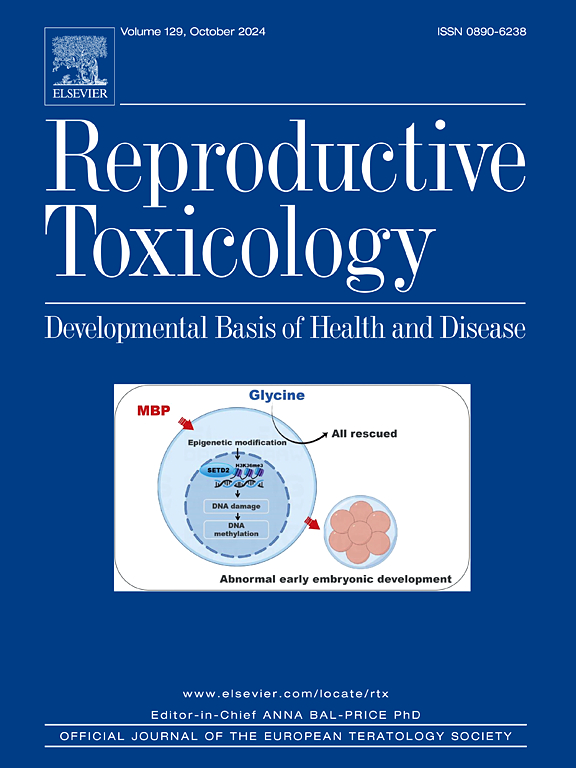低水平环境锂元素暴露影响男性生殖结果:来自中国重庆MARHCS队列研究和体内动物实验的结果。
IF 3.3
4区 医学
Q2 REPRODUCTIVE BIOLOGY
引用次数: 0
摘要
本研究考察了环境水平下锂暴露对精液质量和性激素水平的影响。采用问卷调查法和生物样本法对重庆地区582名大学生进行调查。分别用酶联免疫吸附法(ELISA)和CASA法测定性激素和精液参数。实时荧光定量pcr检测精子端粒长度和线粒体DNA拷贝数。用ICP-MS测定锂含量。此外,给C57BL/6小鼠以环境水平范围内的氯化锂剂量(LiCl;0、4.3、12.8和38.4mg/kg),用western blot法检测睾酮合成关键蛋白的表达。在人群研究中,尿液和精浆中锂含量的中位数分别为18.80和5.38μg/L。尿液和精浆中锂含量升高的每一个四分位数范围都与血清睾酮下降相关(- 2.47%,95% CI: - 4.52%, -0.38%;- 2.67%, 95% CI: - 4.79%, -0.50%精浆)和黄体酮(- 6.38%,95% CI: - 11.09%, -1.42%;- 8.78%, 95% CI: - 13.20%, - 4.04%精浆)。最高剂量(38.4mg/kg)处理小鼠的精子活力、精子浓度、睾酮、孕酮、雌二醇和催乳素水平均显著低于对照组(p < 0.05),间质细胞出现明显的线粒体空泡化和肿胀。这些结果支持环境锂暴露通过损害间质细胞导致精液质量和睾丸激素下降。本文章由计算机程序翻译,如有差异,请以英文原文为准。
Low-level exposure to environmental lithium element affects male reproductive outcomes: Results from the MARHCS cohort study in Chongqing, China and in vivo animal experiments
This study examined the effects of lithium exposure at environmental levels on semen quality and sex hormone levels. Questionnaires and biological samples were collected from 582 college students recruited in Chongqing, China. Sex hormones and semen parameters were measured by ELISA and CASA, respectively. Sperm telomere length and mitochondrial DNA copy number were determined using real-time Q-PCR. Lithium levels were quantified by ICP-MS. In addition, C57BL/6 mice were administered lithium chloride at doses within the range of environmental levels (LiCl; 0, 4.3, 12.8, and 38.4 mg/kg) for 35 days, and the expression of key proteins involved in testosterone synthesis was detected by western blot assay. In the population study, the median lithium levels in urine and seminal plasma were 18.80 and 5.38 μg/L, respectively. Each interquartile range increase of lithium levels in both urine and seminal plasma were associated with decreased serum testosterone (−2.47 %, 95 % CI: −4.52 %, −0.38 % for urine; −2.67 %, 95 % CI: −4.79 %, −0.50 % for seminal plasma) and progesterone (−6.38 %, 95 % CI: −11.09 %, −1.42 % for urine; −8.78 %, 95 % CI: −13.20 %, −4.04 % for seminal plasma). Mice treated with the highest LiCl dose (38.4 mg/kg) had significantly lower sperm motility, sperm concentration, and testosterone, progesterone, estradiol, and prolactin levels than mice in the control group (all p < 0.05), and their Leydig cells showed marked mitochondrial vacuolation and swelling. These results support that environmental lithium exposure leads to decreased semen quality and testosterone by impairing Leydig cells.
求助全文
通过发布文献求助,成功后即可免费获取论文全文。
去求助
来源期刊

Reproductive toxicology
生物-毒理学
CiteScore
6.50
自引率
3.00%
发文量
131
审稿时长
45 days
期刊介绍:
Drawing from a large number of disciplines, Reproductive Toxicology publishes timely, original research on the influence of chemical and physical agents on reproduction. Written by and for obstetricians, pediatricians, embryologists, teratologists, geneticists, toxicologists, andrologists, and others interested in detecting potential reproductive hazards, the journal is a forum for communication among researchers and practitioners. Articles focus on the application of in vitro, animal and clinical research to the practice of clinical medicine.
All aspects of reproduction are within the scope of Reproductive Toxicology, including the formation and maturation of male and female gametes, sexual function, the events surrounding the fusion of gametes and the development of the fertilized ovum, nourishment and transport of the conceptus within the genital tract, implantation, embryogenesis, intrauterine growth, placentation and placental function, parturition, lactation and neonatal survival. Adverse reproductive effects in males will be considered as significant as adverse effects occurring in females. To provide a balanced presentation of approaches, equal emphasis will be given to clinical and animal or in vitro work. Typical end points that will be studied by contributors include infertility, sexual dysfunction, spontaneous abortion, malformations, abnormal histogenesis, stillbirth, intrauterine growth retardation, prematurity, behavioral abnormalities, and perinatal mortality.
 求助内容:
求助内容: 应助结果提醒方式:
应助结果提醒方式:


